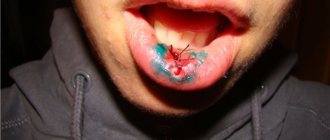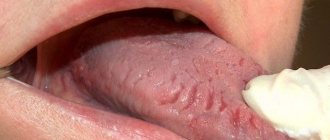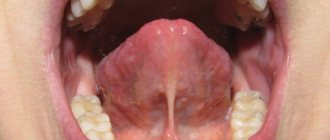The division of the tongue (snake, forked tongue) is called splitting (from the English split - “to separate”). This is an extreme type of body modification, which involves surgically dividing the organ into two parts along the midline, from tip to middle. The purpose of this procedure is self-expression, emphasizing one’s own individuality. Some people resort to this type of body fashion to match fashion and youth trends. Another meaning of splitting is to increase sensuality and expand opportunities in intimate relationships. Kissing and caresses with a forked tongue evoke more vivid sensual sensations in your partner. Most people who decide to split can control the two halves of the tongue separately using muscles.
Features and Precautions
Split tongue is a more complex type of body modification than puncture (piercing). It requires the participation of a qualified performer, preferably with medical, and even better, surgical education. It is not recommended to perform the manipulation at home or in “handicraft” conditions; this task should also not be entrusted to a first-year medical student. To avoid complications, sterile conditions, special drugs (anaesthetics, hemostatic agents) and professional surgical instruments are required. At home, these requirements are difficult to meet.
Before undergoing the splitting procedure, it is necessary to study the contraindications. They are as follows:
- Allergy to anesthetics is very dangerous, because... During the operation, anaphylactic shock and Quincke's edema may develop (an increase in the volume of the larynx and, as a result, the inability to breathe);
- problems with blood clotting, a tendency to bleed, taking anticoagulants (even simple aspirin) can lead to blood loss and require more complex manipulations;
- high temperature, fever and other acute conditions are a general contraindication to any interventions, including surgical division of an organ;
- Oncological diseases are also a general absolute contraindication.
Complications and health consequences should also be kept in mind. If the procedure is performed by an unqualified doctor, this can lead to unfavorable developments:
- infection and tissue necrosis;
- nerve damage.
While the infection is a reversible process that can be stopped with antibiotics, damage to the nerves responsible for sensation and movement is difficult to reverse. This will require more complex and expensive surgery, but a positive outcome is not guaranteed.
When the halves heal, the person still expects specific consequences:
- poor diction (usually it becomes more difficult for a person to pronounce the sounds D, T, R and other fricatives);
- increased hissing and whistling sounds;
- spitting saliva while speaking.
If the procedure is performed professionally, then the taste of food does not change during bifurcation.
Postoperative period
It is not characterized by too complex restrictions or deprivations. The main thing is to prevent infection. To do this, you need to wash the seams with chlorhexidine. To avoid tongue fusion, you will have to wear a tampon with a special medicine. Drinking alcohol, smoking and eating a lot is prohibited.
If you do everything exactly as the specialist recommended, then in a week you can begin to return to normal life.
How is splitting done?
Division into two halves is a surgical operation, it is performed under local anesthesia using a scalpel. Technically, this is a simple operation, although the preparation for the operation and the method of making the incision depend on the experience and chosen technique of the specialist. The standard bifurcation steps are:
- Before surgery, the patient is recommended to brush his teeth and remove white plaque with a brush, then rinse his mouth with an antiseptic solution;
- the doctor injects an anesthetic directly into the tongue;
- With a special surgical instrument, the master clamps the tongue in the middle and leaves the clamp for 30-45 minutes to stop the blood supply at the incision site;
- Using a sterile scalpel, the doctor cuts the tongue into two parts;
- A piece of gauze with an antiseptic is placed between the halves of the fabric.
This algorithm may vary depending on the skill and experience of the performer. Applying a clamp helps keep blood loss to a minimum. Other specialists, in addition to the incision, sutured the two halves to stop bleeding and reduce the risk of tissue infection.
In rare cases, splitting can be performed with a laser, but for this you need to find a specialized medical institution that provides this type of service. In practice, it is very difficult to find, so in most cases, bifurcation is performed surgically.
Background
Surprisingly, such an operation is not something new. It has its own many-thousand-year history, which began literally from the moment of the advent of human civilization. Take yoga, for example. In this teaching, there are ancient practices when the tongue was cut and pulled out in order to later use it in specially designed breathing exercises that allowed a person to cross the line between life and death. In this way, yoga followers could get closer to the so-called Primary Source of all things. By the way, if you look at the images of various ancient Indian deities, you will notice that many of them have forked tongues.
Care, healing time and possible complications
The most difficult period after cutting is the first few days. At this time, a natural reaction of the body is observed - inflammation and swelling. The tongue will hurt and increase in size, making it impossible to speak and eat normally. Within 1-3 days, body temperature may increase - this is a normal phenomenon that can be controlled with antipyretic or anti-inflammatory drugs.
During the first week after the incision, you will have to eat pureed or liquid food. Sour, salty foods (marinades, sauces, tomato juice), spices and other foods that cause irritation will have to be excluded from the diet. After each meal, you should rinse your mouth with an antiseptic solution without alcohol.
To ensure healing occurs faster and the halves do not grow back together, it is necessary to use a special homeostatic sponge, which must be placed between the two parts and changed every 4 hours.
If all recommendations are followed correctly, healing occurs without complications within 1.5-2 months.
Cons of the operation
No matter how beautiful everything sounds, there are still disadvantages to this operation. And there are many of them.
- Blood loss . If the cutting process is unsuccessful and an artery is hit, the person may lose a lot of blood, which can even lead to death.
- Painful sensations. Although the operation is performed under anesthesia, the effect of the painkiller soon wears off. The tongue swells and hurts for a long time.
- Inconveniences in everyday life . Split prevents a person from talking at first. Speech becomes whistling and lisping, and some letters cannot be pronounced at all. The man begins to speak slowly. You will literally have to learn to talk all over again. This will greatly interfere with work or study, but over time, speech will be restored. You can only take liquid food so that nothing gets into the wound. Drinking alcohol and smoking are also prohibited for a long time.
- Long healing . The incision takes about a month to heal and requires constant care. Frequent rinsing and changing tampons make life a little more difficult.
- Repeat the operation . There are cases of split fusion by a few centimeters, but not completely. In this case, you will have to contact the specialist again to correct the cut.
- Infections . During the operation, it is possible that an infection may be introduced into the wound by an unscrupulous technician. Or, if the split is not properly cared for, a person develops inflammatory processes, suppuration and other unpleasant consequences that require treatment.
- Damage . An inexperienced technician can damage the tonsils or nerve endings in the client’s mouth.
- Non-acceptance by society . Not everyone will accept such a modification from another person. This may cause some conflicts and misunderstandings on the part of relatives and superiors.
- The order is not executed nicely. The client may remain dissatisfied with the result if the specialist did not fulfill his specific request (for example, the cut was not the right length) or made the cut crooked.
- Price . A split is more expensive than a regular piercing. This is logical, because the operation is quite serious. On average, the cost of the service ranges from 5,000 to 10,000 rubles. Do not forget about possible correction, which is also not free.
How to choose a specialist for splitting?
Typically, this type of service is provided by specialized salons that perform other cosmetic and minimally invasive operations - piercings, tattoos. Well-established large salons with a good reputation are the best choice. Before starting the procedure, check how sterile the instruments are. You have every right to do this, do not be afraid to offend the master. In self-respecting offices this should not be a problem, and a specialist will be happy to tell you and even demonstrate tools and equipment for sterilizing instruments. If you have the slightest doubt about the reliability of the master, it is better to refuse his services.
Pros of the operation
- Uniqueness . A person decides to take such a step in order to be different from other people. All for the sake of the so-called emotional uplift.
- To attract attention. Anyone who sees such a modification on someone will definitely not remain indifferent. Riveted glances are guaranteed. For young people, this is, in a sense, a manifestation of protest against society, the destruction of stereotypes.
- Popularity. A person with a split will definitely become famous in his circle, since the operation, although fashionable, is quite rare.
- Self-determination . This operation is also performed by people in order to maintain their status as a certain subculture. Most often, punks, emo, and followers of body mod apply for this modification.
- Aesthetics . For some people, a split is a decoration of the body for the soul.
- New sensations. The operation is sometimes performed in pursuit of something unusual that will dilute the gray everyday life. It even becomes possible to control each half of the taste organ.
- Possibility of reverse action . The tongue can always be sewn back together.
Stopping fusion
To prevent the cut from healing, it is necessary to keep the separation open. A hemostatic sponge that needs to be inserted into the incision is well suited for this. This manipulation must be carried out constantly, because healing in the oral cavity occurs very quickly. In addition to the first period of healing, when fusion is regular, it is also observed throughout the year, but not so significant.
Many experts claim that a previously healed tongue piercing acts as an anchor that prevents the halves from fusion. The fact is that there is hard tissue around the piercing that does not grow together on its own. This fabric will not allow the split to grow together.
Causes of tongue frenulum anomaly
Most children have mild pathology, but severe forms are also not uncommon. The size of a child’s tongue frenulum is most often determined by heredity, as well as the following factors:
- viral infection in the mother in the first and last trimesters;
- late toxicosis;
- exacerbation of chronic diseases during pregnancy;
- injuries in the abdominal area during gestation;
- taking potent drugs by the expectant mother.
The danger of folded glossitis
Often, in the absence of any discomfort, scrotal tongue is not treated at all - the anomaly itself does not pose a serious threat to health, except that it increases the risk of penetration and spread of infection, and then the development of inflammation. This situation can occur against the background of a weakened immune system, for example, due to a cold. The situation is aggravated by the inability to properly keep the oral cavity clean, since the defect significantly complicates hygiene procedures. In addition, the problem also affects the aesthetic side of the issue.
What is lingual frenuloplasty?
The frenulum is a small membrane that connects the lower part of the tongue and the mucous membrane of the lower jaw. Despite its small size, it performs very important functions: it is responsible for the formation of dental occlusion, controls the mobility of the tongue and the functioning of the facial muscles.
There are three main pathologies of the tongue frenulum that require surgical correction.
- Wrong shape.
A healthy frenulum is a fold of mucous membrane in the shape of an arc. - Small size
(in medical terminology - ankyloglossia). The average length of the frenulum of the tongue in an adult is 3 centimeters; in a child it is shorter. In the case of ankyloglossia, the frenulum will not allow the tongue to be raised completely upward. - Incorrect mounting location.
A healthy frenulum is attached to the middle of the tongue, and with pathology it can be shifted to the tip.
In some cases, it becomes necessary to perform plastic surgery of the lip frenulum - the fold of mucous membrane connecting the lip and gum. The operation is performed to avoid impaired diction and the formation of malocclusion. Read more about lip frenuloplasty here.
Possible consequences
The procedure must be carried out in a medical environment, in complete sanitation, by an experienced, qualified specialist. First, the specialist must provide you with a paper describing all possible consequences and risks. The master should also familiarize you with all contraindications for the session and provide further recommendations for care.
It is extremely important to go to a proven specialist in whom you are absolutely confident. When cutting the tongue, there is a high risk of blood loss, because the taste organ is filled with a mass of blood vessels. Without experience and the necessary tools, control over the situation is easily lost, in which case it is necessary to immediately hospitalize the client in the hospital.
In addition, there is a possibility of damage to the tonsils, but this risk arises only with a deep incision. The procedure is performed very carefully so as not to touch the nerves of the tongue or damage the tonsils and oral cavity. Infection and scarring are possible, but they are extremely rare.
Symptoms of a shortened frenulum
How to determine if your baby needs surgery? It is necessary to seek specialist advice. However, you can notice signs of a defect in the frenulum of the tongue yourself by paying attention to some details.
- The frenulum resembles a transparent film and does not have a vascular network.
- The tongue is inactive.
- The child cannot reach the upper palate with the tip of his tongue.
- When you move your tongue, clicks are heard.
- Chewing and swallowing are difficult.
- Diction is broken.
- The lower front teeth are turned towards the tongue.











